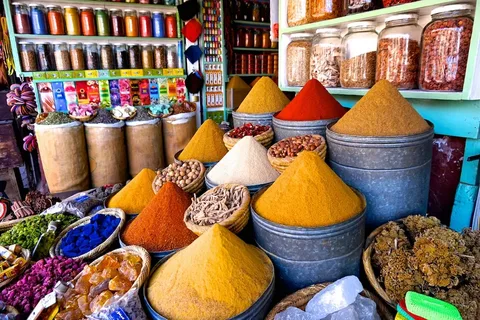What is Moroccan food?, Moroccan food is rich, varied, and shaped by a fusion of Mediterranean, Arab, Berber, and Moorish culinary traditions. Here are some essential components and recipes:
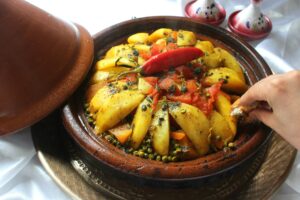 Tagine: A tagine is a type of stew-like meal as well as a cooking vessel. It gets its name from the traditional cooking vessel, an earthenware pot with a conical lid. Meat (such as lamb, poultry, or beef), vegetables, fruits (such as apricots, almonds, or prunes), and a range of spices (including cumin, cinnamon, saffron, and ginger) are frequently combined in tagine recipes.
Tagine: A tagine is a type of stew-like meal as well as a cooking vessel. It gets its name from the traditional cooking vessel, an earthenware pot with a conical lid. Meat (such as lamb, poultry, or beef), vegetables, fruits (such as apricots, almonds, or prunes), and a range of spices (including cumin, cinnamon, saffron, and ginger) are frequently combined in tagine recipes.
To accommodate a range of tastes and inclinations, Moroccan tagines are available in an assortment of flavors and components. Some common varieties of Moroccan tagines are as follows:
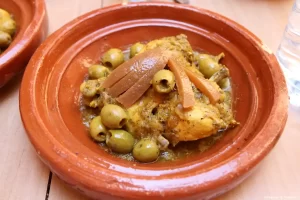
1)Preserved Lemons and Olives in Chicken Tagine: This tagine is made with soft chicken that has been cooked with onions, garlic, cumin, saffron, and other spices. It has the ideal ratio of savory to tart flavors.
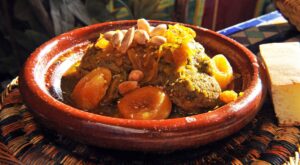 2)Tagine with Apricots and Almonds: Dried apricots, almonds, onions, and a blend of flavorful spices including coriander, ginger, and cinnamon are simmered with lamb in this tagine. The savory lamb and the sweetness of the apricots go so well together.
2)Tagine with Apricots and Almonds: Dried apricots, almonds, onions, and a blend of flavorful spices including coriander, ginger, and cinnamon are simmered with lamb in this tagine. The savory lamb and the sweetness of the apricots go so well together.
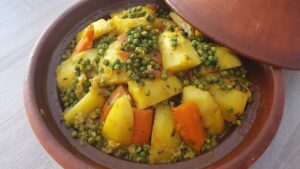 3)Vegetable Tagine: This tagine, which is vegetarian-friendly, blends a variety of in season veggies, including tomatoes, bell peppers, potatoes, zucchini, and carrots. Herbs and spices like turmeric, paprika, and cumin are added to make it a tasty and filling dish.
3)Vegetable Tagine: This tagine, which is vegetarian-friendly, blends a variety of in season veggies, including tomatoes, bell peppers, potatoes, zucchini, and carrots. Herbs and spices like turmeric, paprika, and cumin are added to make it a tasty and filling dish.
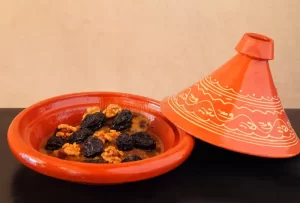 4)Beef Tagine with Prunes and Almonds: This tagine combines tender chunks of beef with sweet prunes, almonds, onions, and a blend of warm spices like cinnamon, nutmeg, and cloves. The result is a rich and comforting dish with a hint of sweetness.
4)Beef Tagine with Prunes and Almonds: This tagine combines tender chunks of beef with sweet prunes, almonds, onions, and a blend of warm spices like cinnamon, nutmeg, and cloves. The result is a rich and comforting dish with a hint of sweetness.
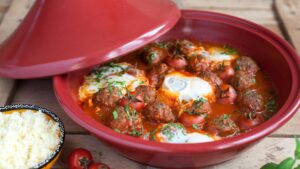 5)Kefta Tagine: Traditionally cooked from ground beef or lamb combined with herbs and spices, kefta is Moroccan meatballs. This tagline is a tasty and filling dish made from simmering kefta in a tomato-based sauce with onions, garlic, and peas.
5)Kefta Tagine: Traditionally cooked from ground beef or lamb combined with herbs and spices, kefta is Moroccan meatballs. This tagline is a tasty and filling dish made from simmering kefta in a tomato-based sauce with onions, garlic, and peas.
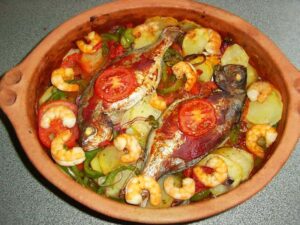 6)Fish Tagine with Chermoula: A classic Moroccan marinade consisting of herbs, garlic, lemon juice, and spices, is typically served with white fish fillets, such as cod or sea bass. After that, the fish is cooked with peppers, tomatoes, and olives to create a bright and colorful dish.
6)Fish Tagine with Chermoula: A classic Moroccan marinade consisting of herbs, garlic, lemon juice, and spices, is typically served with white fish fillets, such as cod or sea bass. After that, the fish is cooked with peppers, tomatoes, and olives to create a bright and colorful dish.
These are but a handful of the numerous varieties of tagines that are used in Moroccan cooking. Moroccans enjoy tagines because they are a flexible and flavorful dish that comes in a variety of combinations.
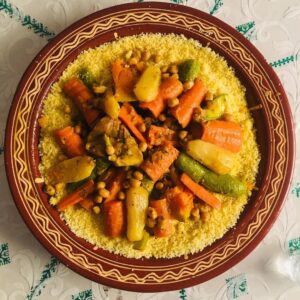 The classic Moroccan couscous dish comprises steaming couscous grains accompanied by a tasty stew made with aromatic spices, meat, and a variety of vegetables. A summary of Moroccan couscous is as follows:
The classic Moroccan couscous dish comprises steaming couscous grains accompanied by a tasty stew made with aromatic spices, meat, and a variety of vegetables. A summary of Moroccan couscous is as follows:
1)Couscous: The little wheat grains known as semolina are used to make the actual couscous. Traditionally, it is steamed to produce fluffy, airy grains that form the dish’s foundation. To keep couscous light and separate, it is commonly made by heating it several times and fluffing it with a fork in between.
2)Vegetables: A vibrant assortment of vegetables, including carrots, zucchini, turnips, tomatoes, bell peppers, and onions, are frequently added to Moroccan couscous. Usually, these veggies are sliced or diced and stewed in the stew until they are soft, adding flavor to the meal.
3)Meat: Moroccan couscous recipes often call for meat, usually lamb, chicken, or beef, while veggie couscous is also a popular option. Often, the meat is browned after being seasoned with a mixture of spices and cooked in the stew with the veggies. Occasionally, a complete meat cut, such as a lamb shank, is included in the stew to enhance its flavor.
4)Spices: Couscous is a staple of Moroccan cuisine, which is renowned for its flavorful spices. Paprika, turmeric, saffron, ginger, cinnamon, cumin, and coriander are common spices used in Moroccan couscous. These spices give the stew richness and flavor by providing warmth, depth, and complexity.
5)Broth: Moroccan couscous stew component is typically made with a savory broth that can be created using stock, water, tomatoes, and aromatic vegetables like garlic and onions. Over this aromatic soup, the couscous grains are cooked, soaking up the flavors as they cook.
6)Garnishes: To enhance texture and freshness, Moroccan couscous is frequently topped with extra toppings. Toasted almonds or pine nuts, fresh herbs like cilantro or parsley, and preserved lemons are common garnishes.
All things considered, Moroccan couscous is a filling and cozy dish that combines grains, veggies, meat, and spices pleasingly. It’s a mainstay of Moroccan cooking that’s loved in homes all over the nation and beyond.
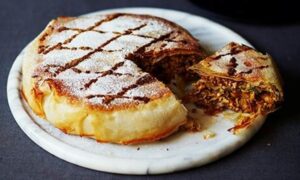 Moroccan Pastilla, sometimes referred to as B’stilla or Bastilla, is a delectable pastry that mixes sweet and savory flavours. It is a classic Moroccan meal. It’s frequently offered as a special meal at festivals, events, and formal get-togethers. A summary of Moroccan Pastilla is provided below:
Moroccan Pastilla, sometimes referred to as B’stilla or Bastilla, is a delectable pastry that mixes sweet and savory flavours. It is a classic Moroccan meal. It’s frequently offered as a special meal at festivals, events, and formal get-togethers. A summary of Moroccan Pastilla is provided below:
1)Pastry: Thin, flaky layers of pastry dough are usually used to make pastillas. Warqa or phyllo dough is traditionally used, while commercially manufactured puff pastry is also occasionally utilized. To achieve a crispy and golden outside, the pastry layers are buttered or lightly drizzled with oil in between each layer.
2)filler: Shredded meat, mainly chicken or pigeon, but other meats like beef or shellfish can also be used, is the typical filler for Moroccan pastilles. In addition to onions and garlic, the meat is cooked with a mixture of fragrant spices like saffron, ginger, cinnamon, and even ground almonds. The filling has a savory, delicious taste, and because honey or sugar is added, it is frequently slightly sweet.
3)Layers: Traditionally, pastilla is put together in layers, with pastry layers encasing the meat filling. Occasionally, to thicken and bond the meat filling, beaten eggs are combined with it. Before baking, the top layer of pastry is frequently sprinkled with cinnamon and powdered sugar to produce a fragrant and delicious crust.
4)Shape: Depending on the cooking pot being used, pastillas are typically formed in a round or rectangular shape. On rare occasions, it is occasionally shaped like a dome and embellished with elaborate designs created from leftover pastry dough.
5)Baking: After the pastilla is put together, it is baked in the oven until the crust is crisp and brown. The filling’s flavors combine during baking, which also makes the dough flaky and light.
6)Serving: Moroccan Pastilla can be served room temperature or hot, as is customary. To enhance the contrast between sweet and savory flavors, it is frequently sprinkled with extra powdered sugar and cinnamon before serving. During celebratory events, pastilla is frequently consumed as the main course or as a unique gift for visitors.
All things considered, Moroccan Pastilla is a distinctive and mouthwatering delicacy that highlights Moroccan culinary talent. It’s a tasty and memorable dish because of the blend of delicate pastry layers, savory meat filling, and sweet topping.
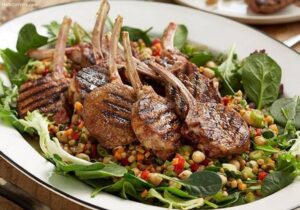 Moroccan Mechoui is the name given to a traditional technique of roasting a whole lamb or a lamb shoulder over low heat until it is juicy and soft. This festive dish is frequently made for important events like weddings, festivals, and get-togethers with relatives. This is a synopsis of Moroccan Mechoui:
Moroccan Mechoui is the name given to a traditional technique of roasting a whole lamb or a lamb shoulder over low heat until it is juicy and soft. This festive dish is frequently made for important events like weddings, festivals, and get-togethers with relatives. This is a synopsis of Moroccan Mechoui:
1)Preparation: The first step in making mechoui is usually marinating the lamb in a blend of aromatics, spices, and herbs. Garlic, cumin, paprika, coriander, saffron, olive oil, lemon juice, and occasionally vinegar are common components in marinades. To enable the marinade to seep thoroughly into the meat, the lamb is frequently pierced or scored.
2)Roasting: After the lamb has marinated, it is typically grilled over an open flame on a spit or skewer, or in a special oven known as a ‘farran’. For several hours, the lamb is slow-roasted, which develops tenderness and infuses the flesh with marinade flavors. To keep the lamb moist and tasty during the cooking process, extra marinade or fat may be based on it.
3)Seasoning: To improve the flavor of the lamb during cooking, it may be seasoned with extra herbs and spices. To get a crispy and flavorful surface, some chefs also brush the lamb towards the finish of cooking with a mixture of melted butter and spices.
4)Serving: The lamb is usually served hot and sliced into serving portions once it has been cooked to perfection. Mechoui is frequently served with couscous, bread, salads, and typical Moroccan sauces like chermoula or harissa.
5)Occasions: In Moroccan culture, mechanic is frequently served during festive events and festivities. As the focal point of a group dinner enjoyed by family and friends, it is a representation of hospitality and giving.
6)Variations: Mechoui is a traditional meal made with roasted entire lamb, although it can also be made with different lamb pieces like leg or shoulder. Furthermore, different parts of Morocco could have their special ways of making mechoui, utilizing regional spices and cooking processes.
All things considered, Moroccan Mechoui is a well-liked meal that highlights Morocco’s extensive culinary heritage. It is a beloved and unforgettable component of Moroccan cooking because of its succulent and tasty flesh that is flavored with aromatic spices.

